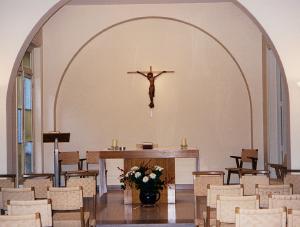Issue Date: April 18, 2003
Care of the soul A small center for religious instruction in Paris made history by making the individual its priority By MARGOT PATTERSON La Maison d’Ananie, or House of Ananias, sits on a residential street in Paris’ 7th arrondissement. Built centuries ago for aristocrats who couldn’t afford the high price of living at Versailles, this part of Paris is lined with dignified white stone mansions and popular with foreign embassies. Here, up the street from the Swedish and Tunisian embassies, the House of Ananias is reached through a quiet courtyard. Inside, the atmosphere is calm, hushed, determinedly discreet. As in the United States, the parishes of France provide catechumenate programs for those interested in becoming Catholic. But the Maison d’Ananie exists to provide religious counseling and education to those who seek private instruction. An illiterate worker, a Japanese woman who spoke little French, and an 80-year-old American man who had flown over from the United States were among those who recently received instruction at the House of Ananias at the time this writer visited. Staff say some people come to the House of Ananias instead of a parish because they have a job that doesn’t allow them to attend regularly scheduled meetings; others have trouble communicating in groups, don’t speak French well enough to thrive in a parish setting, or have complex family circumstances that lead them to seek personal instruction. “Some are very simple people,” said Madeleine De Drée, a lay worker on the staff for 40 years. Others are individuals with a certain fame, notoriety or prominent position who want to pursue their interest in Christianity in a venue that guarantees discretion.
“It’s not bad to have a certain flexibility,” said Fr. Etienne Ostier, the priest in charge of the House of Ananias. “Some people come to us after going to a parish. There are also others who begin with us and go on to the parish.” The House of Ananias takes its name from the Christian disciple Ananias, mentioned in the Acts of the Apostles. Ananias received a vision from Christ, who directed him to Saul of Tarsus after Saul was struck blind on the road to Damascus. Acts recounts that Ananias laid his hands on Saul, whose vision returned and who was then baptized. “Ananias is the symbol of the welcome of the church to those who have some encounter with the mystery of Christ,” said Ostier. The House of Ananias was established as a diocesan mission for non-Catholics at the request of Paris Cardinal Jean Verdier. Jean-Pierre Altermann, a Jewish poet and writer who converted to Catholicism and become a priest, opened the mission in 1938 (see related story). Perhaps sensitized to the needs of non-Christians by his own experience, Altermann was an influential and inspired spiritual director who gave the House of Ananias the tone it has today. Today Paris baptizes several hundred adults every year. The House of Ananias by contrast baptizes only three or four. Still, Ostier, his lay colleagues and officials of the Paris archdiocese believe there continues to be a role for the House of Ananias, ministering as it does to the particular needs of individuals. The house serves both as a center of instruction and a religious meeting point. A group of diplomats from the surrounding embassies in the area brown-bag it once a week at La Maison d’Ananie to meet in faith and conversation. Another group composed of spouses in interfaith marriages meets there regularly as does a study group looking at the Jewish roots of Christianity. Ostier said some people come to the House of Ananias already believers but wanting to deepen their faith, while others have the desire to believe more than the belief itself. “They come looking for reasons to believe,” Ostier said. He quoted Pascal quoting God: “You would not be seeking me if I had not already sought you.” For those looking for a faith they don’t have, one of the signs of the birth of faith is prayer, said Ostier. Prayer, he added, both purifies the person praying and evangelizes him. For adult catechumens, Ostier said the question of vocation is key. So, too, he said is an understanding of the relationship between the Old and New Testaments. A catechesis that neglects the Old Testament will leave catechumens unable to fully appreciate or understand Christianity. “I have the impression that there is a beautiful text by [Dietrich] Bonhoeffer who says Jesus is the last word of God, but you can’t understand the last word if you don’t have a phrase. When Jesus speaks of the reality of the Jewish world, one must not feel that it is in opposition but an enlargement.” A parallel to the House of Ananias does not exist in the United States, where almost all adult catechumens prepare to enter the church through the Rite of Christian Initiation of Adults in their parish. Mercy Sr. Sheila O’Dea, assistant director of the North American Forum for the Catechumenate, said the beauty of the rite adopted by the church in 1972 is that it is neither private nor public but allows for both. Unfortunately, there are occasions in parishes where people preparing for the rite of Christian initiation are not treated as individuals, O’Dea acknowledged. “A lot of us in North America have a group mentality, so it’s like the group is being initiated rather than the persons,” said O’Dea. “The best corrective is to follow the rite. It talks about discernment, about maturing, about community. If you take that seriously, it’s not just instruction, it’s apprenticeship in living the life.” On its 60th anniversary in 1999, Msgr. Francois Coudreau paid tribute to the House of Ananias. Appointed in 1958 as the first diocesan official responsible for adult catechumens in Paris, Coudreau said the instruction provided by the House of Ananias laid the groundwork for his own work. It anticipated the Second Vatican Council and resounds today in the postconciliar era, Coudreau said. He said “a faith which grows from liberty, which searches for faith, and which operates in charity” was the basis on which the House of Ananias was founded. “Thanks to Ananias, the catechumenal institute of the diocese was not founded on rules but was the welcoming of a walk, a walk towards faith. … I received at the House of Ananias the importance of this interior birth which I tried to transmit to all the catechumenal centers which were created in the different quarters of Paris,” Coudreau said. About 30 to 40 new people come to the House of Ananias a year, Ostier said. “One is witness to very beautiful things, but happily one is not at all the master of these things. Faith is born in the relation of the person with God,” said Ostier. Margot Patterson is NCR senior writer. Her e- mail address is mpatterson@natcath.org National Catholic Reporter, April 18, 2003 |

